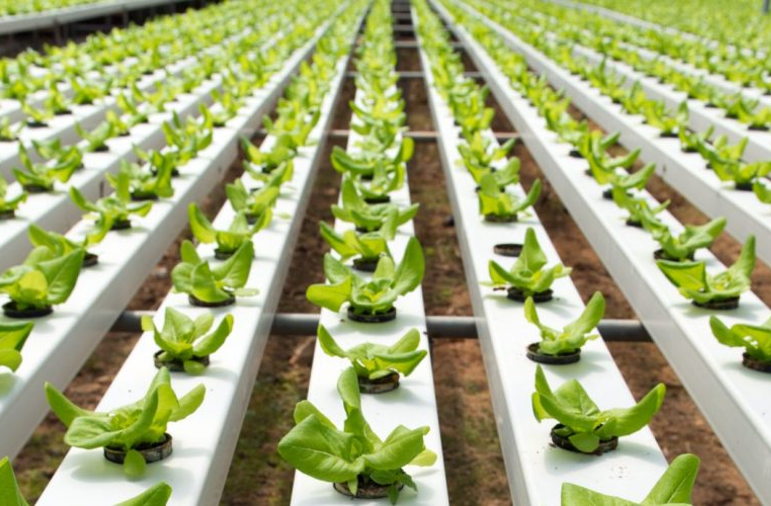As we celebrate World Soil Day 2019, the need for and value of healthy soil continues to be of utmost importance. The statistics are well known: a third of global arable soils are degraded with 25% severely degraded. In the UK, 84% of topsoil has been lost since 1850, and the UK may only be 30 to 40 years away from eradicating its soil fertility. Globally, it is predicted that only 60 years of farming are left if the rate of degradation continues.
Into this grim scenario, comes an expanding new sector: soil-less agriculture. While hydroponic production has been around for some time, its incorporation into ‘vertical farming’ has been a more recent innovation that is taking hold. It falls into a family of practices known as ‘Controlled Environment Agriculture’ (CEA) which includes heated glasshouses and indoor crops sown in soil as well as varied types of hydroponic production, including aquaponics. In Wales, where my husband and I grow organic vegetables on a 23 acre smallholding, CEA is getting a lot of Government support as a vitally important component of Welsh food security and for its ‘sustainability’ – a word I put in quotes because it means different things to different people, and never more so than in CEA.
As I wrote in an earlier piece on vertical farming, the ‘sustainability’ of vertical farming most definitely depends on how it is defined. Most often cited is how little water it uses in contrast to land-based agriculture and this is certainly something to weigh up, especially in a century where water is likely to be a continuing area of conflict, opening up ongoing ‘hydro-politics’. Proponents of vertical farming see a potential new future for agriculture in which the conventional chemical practices of controlling weeds, killing insects and diseases, and the constant striving for productivity present one failure of sustainability; and on the organic side, the lumbering soil-based production and expansive land use is simply not efficient enough to make its sustainability viable in the long run. Vertical farming is a 21st Century agriculture to those involved – better, stronger, faster, and with a lot more money.
Perhaps as we move forward in this turbulent century, there is a place for soil-less agriculture to provide more than just expensive micro-greens. But where is the ecology in soil-less agriculture? This is what concerns me. Soil is a breathing, squirming, thriving, living thing. It gives back to its environment and helps it survive and thrive. That interconnection is important in a world where we are increasingly disconnected from nature – a disconnection which threatens our continued existence on the planet. The most important part of being an organic farmer is taking care of your soil – a good farmer has a deep, enduring relationship with it. This relationship ties you to the earth, compels you to be mindful of what you do on your land. We care what happens in the ground.
It’s hard to have this relationship if you don’t walk your land regularly and smell your soil, to understand what it is telling you. You have to know the weeds and know what they offer you as well as what they take. You have to put your hands in the ground and forge that bond. As fields get bigger, it is this which falls away. If we ride around on tractors, criss-crossing vast tracks of land that produce only one or two crops and leave no space for living things, we cannot possibly understand what is taking place beneath our feet. That soil holds a quarter of the biodiversity of the world, is testament to its profound complexity. Our land is shared with host of other creatures, both great and very small, and as stewards of the farm, we must remember this and live by it.
Soil microbes are fantastic beasts, far more numerous and diverse than all the human population of the earth. Healthy soil imparts its health to the plants that are grown in it, and the plants consequently carry more trace elements and micronutrients. Microbes play an essential role in the nutrient cycles of soil, to humanity’s great benefit. And soil microbes have produced some of our greatest lines of defense against illness – for example, ivermectin– and one common strain of microbes, M. vaccae, has been shown to help our mental health. Recent research on antibiotics has indicated that the earth’s soils might well be the best place to look for new ones. It’s unlikely that an inorganic nutrient solution will ever give us what soil can.
If we lose soil, we ultimately lose ourselves. As said so profoundly by poet and agriculturalist Wendell Berry,
“The soil is the great connector of lives, the source and destination of all. It is the healer and restorer and resurrector, by which disease passes into health, age into youth, death into life. Without proper care for it we can have no community, because without proper care for it we can have no life.”
We need to re-engage people with its magnificence and wonder and foster an enduring understanding of what it is, why we need it and what needs to be done to save it. So, let us not let go of soil, let’s bury ourselves in it more deeply.
Photograph: Aqua Mechanical





